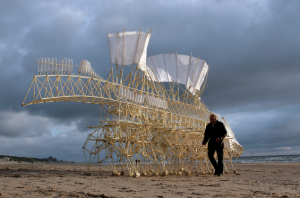Wind-walking artificial lifeform roams Melbourne

MELBOURNE -- The "Strandbeests", the wind-walking sculptures created by Dutch artist Theo Jansen, made their Australian debut today at Melbourne's Federation Square.
As described on Jansen's website, the creatures are mostly made of recycled plastic bottles containing air that can be pumped up to a high pressure by the wind. That pressure is then distributed via various bicycle pumps and plastic tubes which, in turn, drives the beest.
"The best wind speed for [the] Strandbeest is 4m/per second, which lets the wings start to move and store the wind," Mike Matsuhita said, a member of Jansen's team. "Assuming that there would be constant winds of this speed and flat ground without any obstacle, the Strandbeest could continue walking semi-permanently."

Since the first "breed" was conceived in 1990, the Strandbeest has evolved into an increasingly intricate structure, consisting of a rotating spine, legs, stomach (plastic bottles for storing wind energy) and lengthening muscles (pistons within the plastic tubing).
"Theo has been steadily evolving what in many ways can almost be considered a lifeform -- with each new generation of Strandbeest, the creatures are becoming more complex, more responsive, more inspiring," Federation Square's Creative Projects Manager Matt Jones said.
The latest Strandbeests are equipped with "water feelers", a kind of warning mechanism. "They change the Strandbeest’s direction to the opposite way once the feeler touches an obstacle, or once the water feeler detects water," Matsuhita said.
Powered only by wind, the Strandbeests are an inspiration for potential energy saving mechanisms, with the concept holding significant implications for ecology or sustainability.
A spectacular fusion of engineering and art, the moving sculptures have been both inspired by their natural environment and designed to exist within them.
In Dutch, Strandbeest means “beach animals”, with the beach being the natural habitat for testing Jansen's creations. In a TED talk about Strandbeests, Jansen indicated that in the future, he hopes to put these lifeforms out on the beaches to survive on their own.
There are two Strandbeests on exhibition in Melbourne: the Animaris Umerus (measuring 12m long, 4m high and 2m wide) and the smaller Animaris Ordis (4m long, 2m high and 2m wide). Strandbeest "fossils" are also on display, with photos posted on Federation Square's Creative Program blog.
Photo: Loek van der Klis
This post was originally published on Smartplanet.com